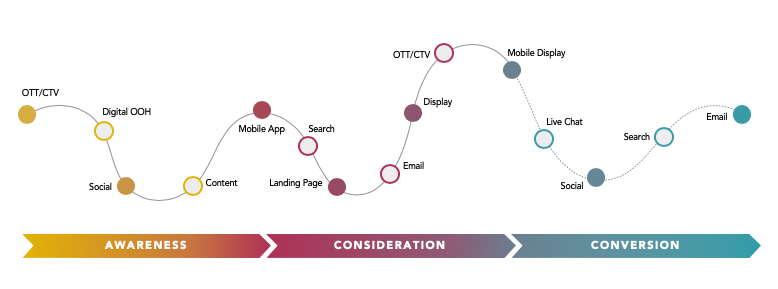A little more than two decades after it first launched, programmatic advertising has solidified its place in the advertising ecosystem. Projected to account for $81 billion worth of digital display ad dollars by 2021, it’s no longer a question of if programmatic advertising will dominate digital advertising. Owning 85% of the display ad market share, the numbers speak for themselves.
As advertisers are beginning to invest more heavily in programmatic advertising, we understand that there are some challenges you may face. We’ve outlined 3 of the biggest programmatic advertising challenges advertisers experience and technology-based solutions to combat them.
What is programmatic marketing?
Programmatic advertising is the automated buying and selling of online advertising between brands and/or agencies and suppliers. The brands or agencies use a demand-side platform, or DSP, to essentially decide which impressions to buy and how much they should pay for each impression. The suppliers use a supply-side platform, or SSP, which is where they sell these impressions to brands and agencies.
What are the biggest programmatic advertising challenges – and their solutions?
1. Viewability & Impression Fraud
Ad fraud has been a concern amongst advertisers from the very start of display advertising. Not exclusive to programmatic advertising, ad fraud still remains the top concern throughout the digital advertising industry. As the success of digital ads is measured based on impressions and views (or other similar KPIs), advertisers need to be certain that these views, clicks, etc. are coming from humans, and not alternative malicious forms to drive performance.
Ad fraud can come in a variety of forms such as bots, ad stacking, and ghost sites (you can learn more about the different types of ad fraud here). These tactics work to drive performance numbers but offer no real human interaction with ads. These ad “impressions” are still paid for with the campaign budget, which in turn wastes campaign dollars and drives performance down.
This problem is not lost on digital advertising industry leaders. In an effort to stay one step ahead of these ad fraudsters, companies are investing in smarter, more advanced technology to give advertisers peace of mind that their ad is being seen by a human. Many companies offer solutions to combat ad fraud that include using machine learning or AI to detect patterns that seem to mirror ad fraud. Humans then review this activity and analyze data and patterns to better understand how ad fraud enters the advertising eco-system. This information, both from machine learning and humans is implemented into technologies to prevent new non-human traffic from entering platforms in the first place. Google is one of the industry leaders carving a path toward a fraud-free world, using a system just like the one mentioned above.
The Solution(s)?
At Digilant, we have a very strict vetting process to ensure our programmatic partners – DSPs, PMPs, etc. have advanced ad-fraud fighting measures in place. However, in addition to this, we also have a suspicious traffic filter. Digilant’s built-in suspicious traffic filter is a safety precaution that detects and eliminates fraudulent traffic. Even if the traffic cannot be confirmed as fraudulent, but exhibits similar attributes, it is classified as suspicious. Our four different levels of sensitivity – light, moderate, strong, and maximum – allows each brand to choose how heavily they want traffic to be filtered.
2. Inventory Quality
Programmatic inventory refers to the ad inventory that a publisher makes available to programmatically purchase on the open market. This inventory is then bid on, in real-time, which in turn, places the ad in front of the viewer. Think about when you are browsing online and you open a webpage, most likely display ads load alongside the content you’re viewing. This is going on across everyone’s browser all over the US and world. The amount of inventory up for grabs is not a problem – there is no shortage.
However, the reason advertisers are so keen on programmatic advertising is not for the quantity, it’s the quality. Programmatic advertising allows brands to place their ads in front of relevant, interested consumers – increasing the chances that they interact with the ad. When thinking about programmatic advertising challenges, it’s not a matter of inventory quantity, advertisers are consumed with how to get the best quality.
The Solution(s)?
The solution to ensure high-quality inventory works similar to the ad fraud solutions mentioned in the section above. However, at Digilant we have additional tactics that advertisers can use to combat inventory woes.
Digilant Premium
Privileged Access to 1,000+ publishers that are all 100% Ads.txt verified with the ability to layer custom audience targeting.
This is a simple, flexible method for publishers and distributors to clearly state which companies are authorized to use their digital inventory. Companies drop a text file on their website that lists the different companies authorized to sell inventory on their site. This will enable buyers to see which programmatic firms have authorization to sell ad space on specific websites, ensuring validity in their purchase. The upkeep for this process is also simple. Someone will have to monitor additions to an ads.txt list to stay up to date with authorized sellers.
Page Index
Our custom “allow-list” solution curates a customized network of sites and pages that both free of ad fraud threats and meaningful to your brand’s overall objectives and messaging.
Private Marketplace
Digilant’s programmatic partner include strategic private marketplace (PMP) partners across industries such as travel, healthcare, and education. PMPs ensure advertisers know exactly which sites their ads will be shown on so they don’t have to worry about ghost sites or masking URLs.
3. Brand Safety
Again, brand safety is not a challenge exclusive to programmatic advertising, but rather something advertisers are challenged with throughout display and digital advertising. Brands want to ensure their ad content is not shown next to negative, controversial, violent or otherwise potentially brand-damaging content.
There have been a few very noteworthy examples of brands fighting against platforms who placed their ads next to questionable or harmful content, however most recently this came to light at the start of the COVID-19 pandemic. Brands wanted to ensure their messaging aligned next to factual, trustworthy articles and content – they were apprehensive that their ads would be placed next to content that was spreading false information to consumers. And for some brands, they wanted to avoid their ads appearing next to COVID-19 related content in general.
No matter the reasons for why your brand doesn’t want to appear next to certain genres of content, it’s important that those limitations are implemented across all campaigns.
The solution(s)?
The solutions mentioned above all will work in tandem to help fight ad fraud, eliminate inventory concerns and promote ease of mind for brand safety. But, there are a few different tactics our team can implement to ensure your brand image remains strong and ads only appear next to content you approve of.
Blocklists
Digilan’t page index feature allows you to “allow” certain websites where you want your ads to run, however if you would like to take precautionary measures a step further, blocklisting is a good solution. Digilant continuously updates a universal list of blocklisted sites that we implement into every campaign, but we offer brands to add any custom blocklists to campaigns as well.
Masked URLs
Although not all masked URLs are harmful to your brand, Digilant can run campaigns on transparent URLs to ensure we are not running on blocklisted sites.
What is a masked URL?
A masked (or non-transparent) URL does not contain the URL in the bid request. A semi-transparent URL is a generic URLs that gives some indication of inventory source without disclosing the specific site.
4. Creative Forms for Programmatic (variety of sizes/formats)
Many advertisers find one of the biggest programmatic advertising challenges to be the different ad sizes necessary for the variety of ad formats available. Not including programmatic video and audio, there are still mobile, tablet, and desktop display units all in a variety of sizes that advertisers need to be cognizant of for their campaigns. It can be a rather cumbersome process to identify and create these different formats for ads.
The solution(s)?
Not only do the advertisers have to think about the different sizes required to run a programmatic advertising campaign, but they also have to be visually enticing for consumers. The Digilant team has a variety of creative best practices we suggest for advertisers, learn more about our creative strategy and development tactics here.
Social to display
Many brands already have a strong social media presence which includes quality, engaging creative content. Using a social to display strategy allows advertisers to take these high quality social media images and use them as display ads across a variety of DSPs. This allows the content to be used across a variety of platforms, minimizing creative creation and maximizing consumer engagement.
Dynamic Creative Optimization
If advertisers don’t have the bandwidth to create multiple ad forms for varying products offers or occasions, dynamic creative optimization (DCO) is a great solution. DCO uses technology to place creatively relevant ads based on the viewer data, including where that specific consumer is in the buying cycle. An example of this is reaching cart abandoners with carousel ads showcasing the products they were looking at along with a message such as “Don’t wait, the items in your cart will expire in 30 minutes!” Using a DCO solution lessens creative lift with technology that creatives these ad forms, rather than manually creating all the different potential ad forms.
Learn more about why you should pay extra-close attention to the importance of DCO during this holiday shopping season here.
5. Knowledge
DSP, SSP, DMP, CTR, DOOH, CCPA, RTB – and the list goes on and on. Between the new acronyms, terminology, tactics and policies that are constantly evolving in the programmatic industry, many advertisers feel as though they are falling behind is what is most up to date. But, you’re not alone; Bannerflow reports that 50% of people using programmatic advertising, don’t fully understand it.
With a wide variety of platforms and buying options, it can be difficult to navigate which option is best for your campaign, or brand in general. And as you try to navigate which channel is best to run your ads on, you also have to keep up with the evolving and growing consumer privacy laws.
The solution(s)?
Find a programmatic partner that alleviates knowledge-overload stress, along with all of the programmatic advertising challenges mentioned above.
Digilant combines internal programmatic expertise with strategic industry partnerships to ensure that you’re able to reach niche audiences across multiple platforms, all while remaining fraud free and brand safe. Our data-driven, actionable, and effective strategies have remained successful because we continually innovate to help our clients with purpose-built solutions tailored to their needs. Our team of data experts is armed with leading industry knowledge and a passion for data-driven results to ensure your campaigns are optimized for top-quality inventory success.
We know the challenges that brands and agencies face. More pressure than ever to quantify business impact, greater trouble keeping pace with emerging channels, and an increasing need for digital media platform experts. With Digilant’s managed service offering, we make biddable media buying simple and challenge-free. Interested in learning more about how Digilant’s technology based solutions can solve for all your programmatic marketing challenges? Let’s talk!


